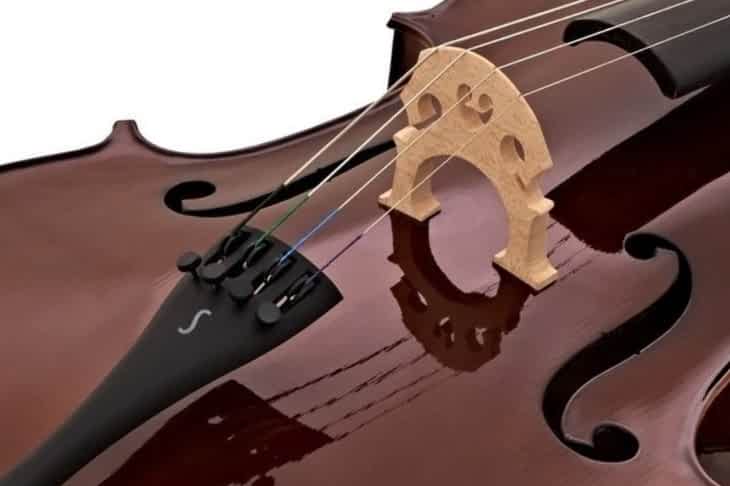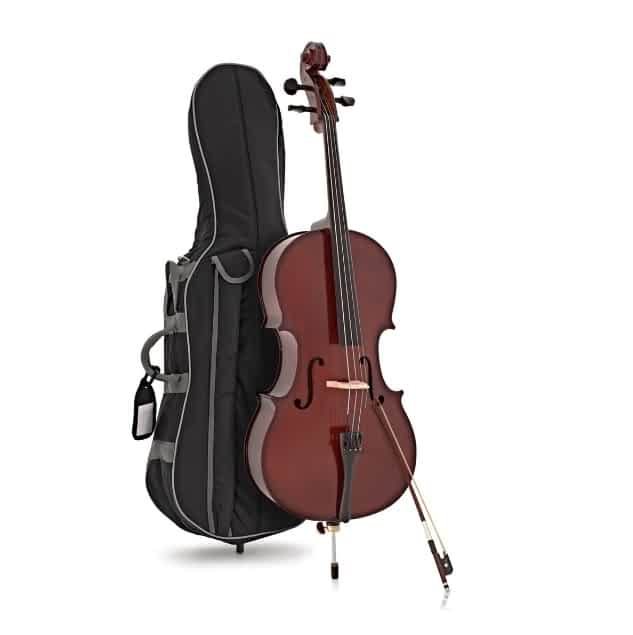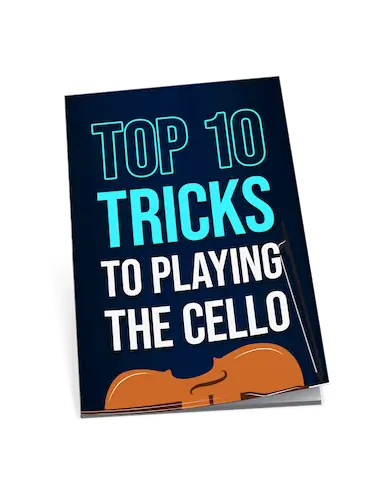Best
Cello for
Beginners
-
Overall: Durable yet precise pau rosa tuning pegs
-
Best Feature: Solid tonewoods for a superior sound
-
TedScore™: 9/10
Best
Premium Quality Cello for Beginners
-
Overall: Designed with attractively flamed maple back and sides
-
Best Feature: Redefines all expectations of a student cello outfit
-
TedScore™: 9.8/10
Best
Budget Cello for Beginners
-
Overall: Hand-carved maple and spruce body
-
Best Feature: Durable ebony pegs and fingerboard
-
TedScore™: 7.8/10
Tuning a cello might seem scary at first, especially if you’re new to it. Knowing how to tune a cello is important to make a beautiful sound and improve your musical journey.
Believe me, once you get used to it, it becomes easy.
We’ll explore the basics of cello tuning, from learning the names of the strings to using tuning pegs and fine tuners well. Whether you like tuning by ear or with a digital tuner, I’ve got tips and tricks to simplify it.
Keep reading as we discover the secrets to tuning your cello perfectly. Let’s start this musical adventure together and make those strings sing!
The Art of
Cello Strings Tuning
Ah, the sweet sound of a perfectly tuned cello! It’s music to your ears. But tuning your cello strings can be challenging, especially if you’re new to the game. Fear not, dear reader, for we are here to guide you through the art of cello string tuning.
First things first, let’s talk about the basics.
The cello is a four-string instrument tuned in perfect fifths. The corresponding strings are tuned to the notes C, G, D, and A; with C being the lowest and A being the highest. Remember this order, and you’ll be well on your way to tuning your cello strings like a pro.

Now, there are a few ways to tune your cello strings. You can use a tuner, a simple tuning fork yourself, or even a piano. If you’re using a cello tuner, make sure it’s set to the correct pitch and that you’re plucking the right string.
If you’re using a tuning fork, strike it against a hard surface and place it on the body of your cello near the bridge to tune your A string. Alternatively, you can use a piano to tune your cello strings to the correct pitch.
Once you’ve got the basics down, it’s time to fine-tune your cello strings!
Tuning your cello strings is a fine art that takes practice and patience. With a little effort, you’ll be playing beautiful music on your perfectly tuned cello in no time!
Understanding
the Cello's Anatomy
Strings
The cello has four strings – C2, G2, D3 and A3. Each string has a different thickness and tension, which produces a unique sound.
The strings are attached to the tailpiece at the bottom of the cello and run over the bridge, which is an open c string, positioned more than two strings on the soundboard.

Soundboard and Scroll
The soundboard is the top part of the cello that resonates when the strings are played.
Keeping the soundboard clean and dust-free is important to ensure the best sound quality.
The scroll is purely decorative but adds a touch of elegance to the instrument.

Bridge and Tailpiece
The bridge is a small wooden structure that supports the strings and transmits the vibrations from the strings to the soundboard. It’s important to ensure the bridge is correctly aligned to maintain the correct tension on the strings and prevent damage to broken strings or the soundboard.
The tailpiece is located at the bottom of the cello and holds the strings in place.

Some stringed instruments like the cellos have four fine tuners also attached to the tailpiece, which allows for more precise tuning adjustments. However, if you have an older cello, you may need to tune it using the four tuning pegs up at the top.
The Impact of
Climate on Tuning
Let’s take a closer look at how different climate factors affect your cello tuning process.
Temperature
Humidity
Tension
Atmospheric Pressure
How to Tune Your Cello
Step 1: Get Your Equipment Ready

COMES WITH: Multi-colour display in a compact design
FEATURES: simple interface with intuitive buttons
D'Addario Eclipse Cello/Bass Tuner
When you check the price above, you’ll see there are loads of great places to buy this item. Our personal favorite is Gear4music.
It is the largest music retailer in the UK and fast becoming the most respected online music shop in the US too. Their customer service is excellent, they have competitive prices, really fast shipping, and usually have the longest guarantee.
Most professional musicians use Gear4music, so there is no reason why you shouldn’t too!
- Provides precise tuning feedback
- User-friendly for both beginners and experienced players
- Optimized to handle the low frequencies and vibrations
- D'Addario is a reputable brand
- Designed specifically for cellos and basses only
The professional musician who wrote this article combined many things,
from the product build, manufacturer’s reputation through to feedback
from other users, to create our famous TedScore™.
Step 2: Tune Your Cello Strings
Step 3: Check Your Intonation
Step 4: Adjust Your Bridge Alignment
Step 5: Practice, Practice, Practice
Don't get discouraged if it takes a while to get the hang of it. Keep practising, and you'll soon be able to tune your cello like a pro!
Remember to keep your cello in standard tuning, with the A string tuned to A4 (440 Hz). And don't forget to have fun!3 Best Cellos for Beginners

PERFECT FOR: beginner players
FEATURES: Solid tonewoods for a superior sound
OTHER INFO: Durable yet precise pau rosa tuning pegs
Stentor Student Cello
When you check the price above, you’ll see there are loads of great places to buy this item. Our personal favorite is Gear4music.
It is the largest music retailer in the UK and fast becoming the most respected online music shop in the US too. Their customer service is excellent, they have competitive prices, really fast shipping, and usually have the longest guarantee.
Most professional musicians use Gear4music, so there is no reason why you shouldn’t too!
- Wooden bow included so you can play right away
- Gig bag has backpack straps for easy transport
- Fingerboard is not made of ebony
The professional musician who wrote this article combined many things,
from the product build, manufacturer’s reputation through to feedback
from other users, to create our famous TedScore™.

PERFECT FOR: beginner players
FEATURES: Durable ebony pegs and fingerboard
OTHER INFO: Hand-carved maple and spruce body
Primavera 100
When you check the price above, you’ll see there are loads of great places to buy this item. Our personal favorite is Gear4music.
It is the largest music retailer in the UK and fast becoming the most respected online music shop in the US too. Their customer service is excellent, they have competitive prices, really fast shipping, and usually have the longest guarantee.
Most professional musicians use Gear4music, so there is no reason why you shouldn’t too!
- Excellent beginner cello
- Includes a bag, bow, and rosin
- Pricier compared to other beginner cellos
The professional musician who wrote this article combined many things,
from the product build, manufacturer’s reputation through to feedback
from other users, to create our famous TedScore™.

PERFECT FOR: beginner and student players
FEATURES: Redefines all expectations of a student cello outfit
OTHER INFO: Designed with attractively flamed maple back and sides
Hidersine Vivente Cello
When you check the price above, you’ll see there are loads of great places to buy this item. Our personal favorite is Gear4music.
It is the largest music retailer in the UK and fast becoming the most respected online music shop in the US too. Their customer service is excellent, they have competitive prices, really fast shipping, and usually have the longest guarantee.
Most professional musicians use Gear4music, so there is no reason why you shouldn’t too!
- Front made from selected straight-grained spruce
- Based on a traditional tonal core
- Includes octagonal bullet wood bow and padded gig bag
- Expensive cello
The professional musician who wrote this article combined many things,
from the product build, manufacturer’s reputation through to feedback
from other users, to create our famous TedScore™.
Cello Strings Tuning
Summary
Tuning a cello might seem daunting, but it becomes second nature with some practice. I remember my early cello practice sessions; every session felt like a quest for the perfect note.
Nifty Breakdown:
- Use digital tuners or apps: They’re convenient and accurate.
- Understand peg and fine-tuner usage: Pegs are for big adjustments, and fine-tuners are for small tweaks.
- Regular Maintenance: Keep your strings in good condition.
Starting with a digital tuner is the easiest way for beginners to get accurate pitches. Fine tuners are brilliant for making precise adjustments without much fuss.
Patience is your best friend here. Take your time with each string. The result? Beautiful, harmonious music that brings joy to the soul.
Happy tuning!
Before you go…
Explore our collection of 17 essential accessories for string players to elevate your musical experience! Whether you need tuners, rosin, or cases, This article has everything you require to enhance your instrument’s performance!
FAQ's
A 5-string cello is typically tuned to C-G-D-A-E, with the additional low E string being tuned to the same pitch as the lowest string on a standard, d string or 4-string cello.
No, the cello and violin are not tuned the same. The violin is typically tuned to G-D-A-E, while the cello is tuned to C-G-D-A.
The A cello is typically tuned in the key of C, with the strings tuned to C-G-D-A from lowest to highest.











While I appreciate the insight into the cello’s tuning process, I believe the article could have benefited from a deeper exploration of how different string brands can affect overall sound quality and tuning stability. Various materials and manufacturing processes can drastically alter a string’s response to climatic conditions and tension adjustments. Delving into this aspect would provide readers with a more rounded understanding of the nuances involved in maintaining their instrument.
I found the section on How to Tune Your Cello incredibly insightful. Before this, I struggled with tuning by ear, but following the steps outlined by Carina Drury, I noticed a significant improvement. The tip about checking the bridge alignment was a game changer for me. My cello has never sounded better, and I’m more motivated than ever to continue practicing. Thanks for this comprehensive guide!
Glad you guys found it helpful! Bridge position is key for a good sound.
Eliza_M, totally agree! The bridge alignment tip was a lifesaver. Made such a difference.
read about the impact of climate on tuning and totally agree. i noticed my cello sounds way different when the humidity spikes. always a struggle to keep it in tune during the summer!
hey Carina, cool article! quick q: does tuning your cello really change much if you’re just starting to learn? thanks!